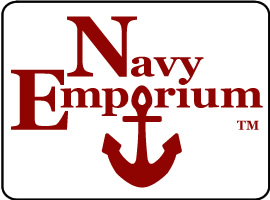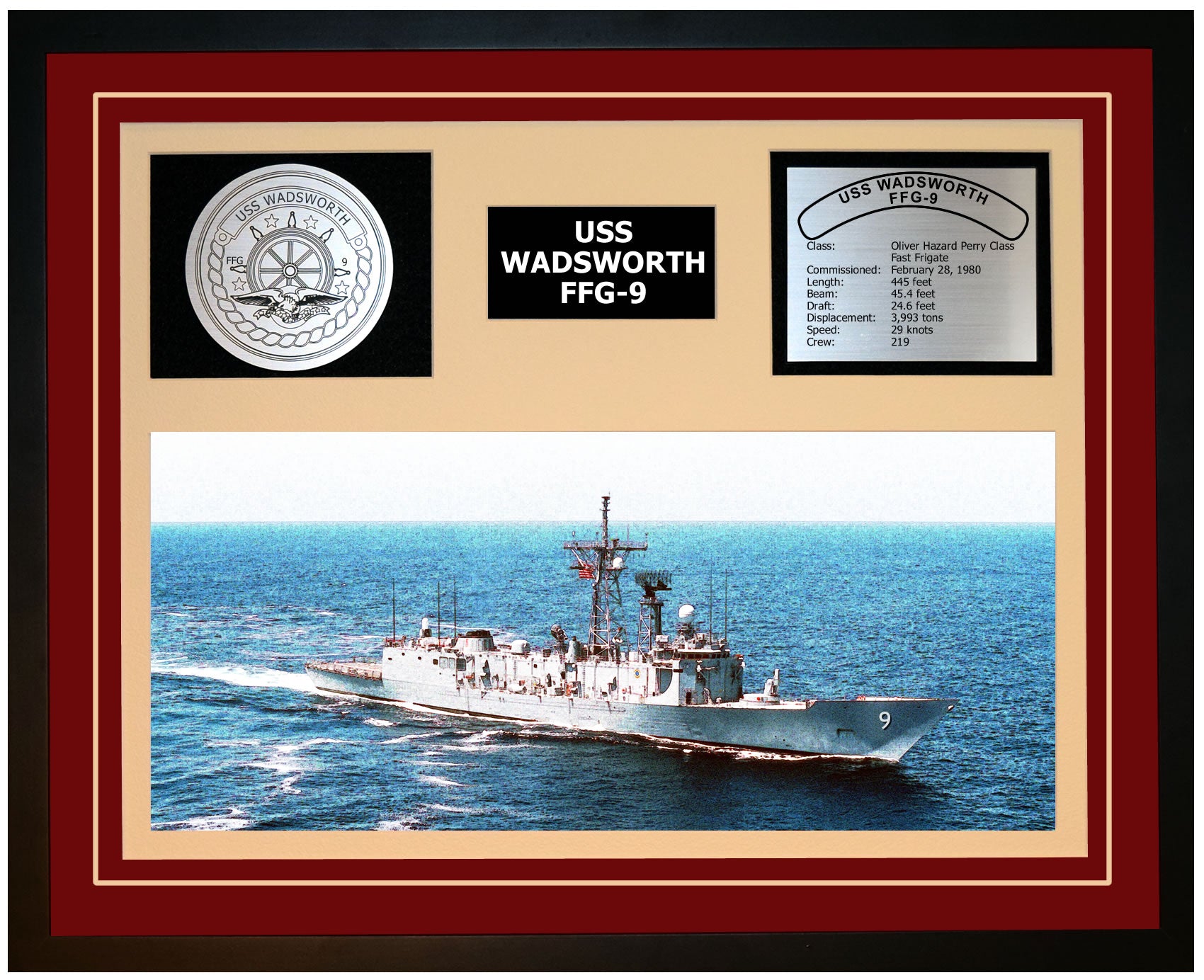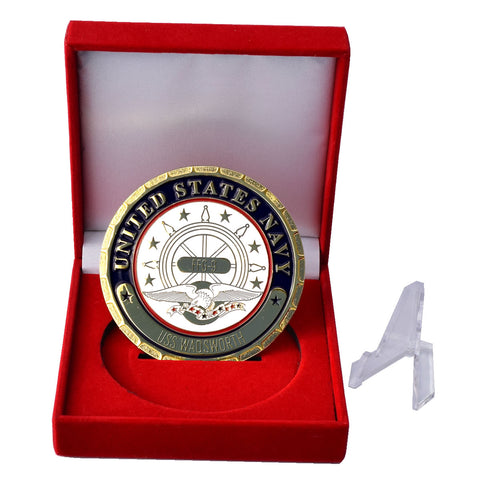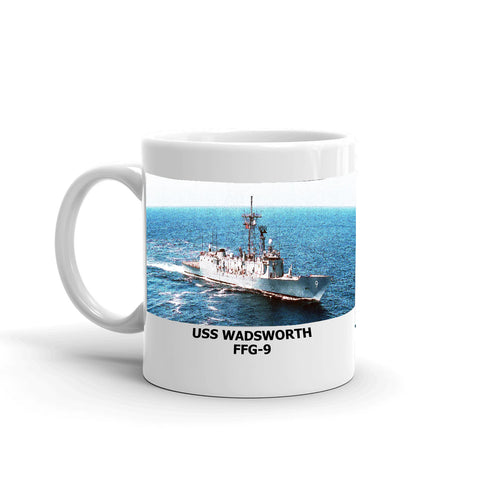This naval beast was a game-changer, always on guard and keeping our waters locked down tight. Well, this old ship has quite the story behind her. But it's not just about frigid arms and submarine rockets; there's so much more to this tale. This is a narrative of courage under pressure, recounting adventures from foreign lands and resonating with the echoes of past conflicts.
This missile frigate wasn't named randomly; it bore the name of Commodore Alexander Scammel Wadsworth -a man who stood tall in times when courage was currency. But what was it that made this ship stand out in a sea of others? What distinguished her from countless others cutting through ocean waves?
So, we're embarking on a journey through time that'll take us from the birthplace of USS Wadsworth in San Diego to its legendary service in world wars—revealing how it's not just another name but an epic tale etched in navy logs.
The Construction and Commissioning of USS Wadsworth FFG-9
Construction of the iconic USS Wadsworth FFG-9 started with a bang on July 13, 1977. This ship, which would soon become an indispensable part of the United States Navy's fleet, was crafted meticulously over months at Todd Shipyards Corporation in San Pedro.
The Building Process of the Vessel
Just as Rome wasn't built in a day, neither was this mighty vessel. After her keel was laid in '77, it took a bit over twelve months before the planet saw what would become one of America's most powerful missile-carrying frigates. The USS Wadsworth (FFG 9), launched into service on July 29th, 1978.
Captivatingly enough though - and here's where things get really interesting for our history buffs out there - she didn't officially join active duty until February 28th,1980. Indeed. That's no joke, you've got it spot on. A whole two years later.
This is because commissioning isn’t merely about slapping some paint onto metal sheets or sticking guns to hulls; no sirree. It’s like preparing an athlete for game day: grueling tests were conducted to ensure every gear ticked perfectly while high-stakes drills tested crew readiness against potential threats at sea – not exactly child’s play.
Proud Tradition meets Cutting-edge Technology
Akin to shaping diamonds from coal under extreme pressure over time; similar patience goes into creating such formidable military assets – balancing traditional naval principles with modern technological advances.
Beneath her sleek silhouette hid layers of meticulously assembled components, each serving a distinct purpose. From the hull that protected her against unforgiving ocean currents to advanced weaponry ready to defend national interests – every bit of this warship was optimized for endurance and firepower.
Its elaborate design reveals greater meaning upon closer inspection.
Think of it as slowly peeling an orange; each layer you remove gives you more insight into the whole, beautifully crafted story. Hang tight with me here, as unraveling the nuances of how things come to be can genuinely expand your perspective.
Shared Voyages: A Mosaic of Memories from USS Wadsworth FFG-9
We uncover a vault of vivid memories that encapsulate the essence of naval life, as recalled by the crew who called her decks their own. The reflections range from the pride of service to the personal anecdotes that bind these sailors together, even years after their service.For SKC (SW) Don Carr, the USS Wadsworth represented a gateway to naval life, an experience so profound that it fostered connections he seeks to rekindle today. The ship, affectionately known as the Mighty Wads, emerges in his narrative not just as a vessel but as a community, a sentiment echoed by Anthony Precie, who recalls rigorous operations and the camaraderie of shared achievements.
Kevin Ransom, RM3, and Anthony Boddie, YNSN/SKSN, remember the ship as a backdrop to the bonds they formed—friendships that extended beyond the ship’s steel confines to the basketball courts and barber shops of Long Beach. Such details are not trivial; they represent the fabric of daily life for sailors at sea.
GMG3 Eric Culpepper and SH1 Leroy Beavers reminisce about the teamwork and pride that characterized their time aboard. The sense of unity and achievement, from earning the Battle 'E' to the tearful farewell in Mayport, illustrates the profound connection between the crew and their ship.
The Mighty Wads was not only a home but also a foundation for growth and change, as seen through the eyes of DC2 Sean Bengsch and GSM2 Todd Fultz. The plaques, the first night on a new ship, and the recollection of firsts and lasts are recounted with a blend of humor and longing.
There's also a thread of continuity in the stories of those like DS2 Dale Mogk and RM2 Michael Barney, whose careers took them from the high seas to the architectural firms of Portland, indicating the ship's role in shaping futures. Similarly, EW1(SW/AW) Paul Mayfield and LT Jim Pluth speak to the enduring impact of their naval experiences in their post-service careers.
YN1 Skip Geiger, ET3 John Hessenauer, and EW3 Brian Stickler recount their specific duties and the shared experiences that created an indelible bond among the crew. Terry YN1 Baker’s account of the reservists’ life aboard provides insights into the diverse commitments of those who served.
The global travels recounted by RM2 Aquaro and the law enforcement operations remembered by OS2 (SW) Tom Barkwell reflect the multifaceted missions and the personal growth that came from their service.
The ship was a crucible for transformation for many, such as Greg Carlton, who left for a career in photography, and Jeffrey Post, whose role as DISBO was made bearable by the support of his crewmates. These stories, along with Matt Dube's lost ring narrative, weave a rich fabric of personal and shared histories.
As FC2 Roderick Bell concludes, working for the FAA yet still recalling the days of getting underway, the USS Wadsworth stands as more than a ship—it's a chapter in the lives of its crew that continues to resonate with a sense of adventure, camaraderie, and pride.
ensure the ship was ready for duty. After a lot of blood, sweat and tears, this marvel of American engineering has finally reached its peak - a shining example of dedication meeting perfection.
The Namesake Behind USS Wadsworth FFG-9
Commodore Alexander Scammel Wadsworth, born in 1790, was more than just a man with an impressive name. His dedication to the U.S. Navy set a powerful precedent, so much so that they honored him by naming three naval vessels after him. To truly grasp the breadth of his inspiring life story, you'll find no better resource than the Wadsworth Family in America site.
Alexander Scammel Wadsworth hailed from a family known for its dedication to military service and patriotism. A namesake for USS Wadsworth FFG-9, he rose through ranks starting as second lieutenant of Constitution during world wars and eventually becoming master commandant leading Mediterranean Squadron on brig Prometheus among other ships.
In terms of leadership skills, few could rival Commodore Alexander Scammel's achievements at sea. He commanded frigate Constellation against British frigate Loire which led to submarine sinkings under his watchful eyes protecting convoy protection efforts in West Indies waters where enemy aircraft were constant threats.
Commanding Officer During Pivotal Moments
A commanding officer par excellence. That's what best describes Commodore Alexander who oversaw critical combat actions earning multiple battle stars during World War II era when he held positions such as Commanding Officer on board Sloop John Adams besides being part of ship crews like Frigate Constitution before advancing further up within naval hierarchy.
Promoted by Navy Commissioners because they recognized his unique strategic acumen – it’s clear why there have been so many guided missile frigates named 'WADSWORTH' over years.
The Man behind Naval Innovations
No discussion about USS Wadsworth can be complete without mentioning the contributions of Alexander Scammel Wadsworth to naval innovations. Thanks to Wadsworth's critical hand in fine-tuning the Navy's missile guidance tech, ships like USS Wadsworth FFG-9 came out swinging with unmatched convoy protection prowess.
He even helped design Oliver Hazard Perry class frigates which included features such as advanced enemy shore installations attack capability using ship’s unique combat actions tactics. This made him a legend not just on land but also at sea.
Commodore Alexander Scammel Wadsworth, the namesake of USS Wadsworth FFG-9, was a naval hero with a rich legacy. His military prowess and strategic brilliance earned him respect in naval ranks and guided missile frigates were named 'WADSWORTH' in his honor. Moreover, he played a pivotal role in ramping up the Navy's potential.
Distinguishing Features and Specifications of USS Wadsworth FFG-9
One glance at the USS Wadsworth FFG-9, and you know it's not your average ship. With a design that's all about function and specs screaming strength, the USS Wadsworth FFG-9 is far from your typical ship.
The Unique Characteristics of the Vessel
Sporting a displacement of 3,600 tons, this naval behemoth stands tall among others in its class. But size isn't everything; the real charm lies in her well-thought-out dimensions. A length stretching to 445 feet allows for swift navigation through challenging waters. With a beam measuring 45 feet across, stability during high-seas operations is guaranteed.
The vessel also boasts an optimal draft depth - standing at about 24 feet 6 inches – just enough to maneuver near coastal areas effectively without compromising on speed or performance. Speaking of speed, don’t let her heavy build fool you. The USS Wadsworth can easily outpace most adversaries with top speeds crossing over the formidable barrier of 28 knots.
Armament and Weaponry Overview
Apart from structural features that make it stand apart as an Oliver Hazard Perry-class guided-missile frigate (FFG), what truly defines USS Wadsworth’s might are its armaments - designed for versatile combat actions ranging from convoy protection against enemy aircrafts to submarine sinkings.
This battle-hardened veteran doesn't shy away when duty calls but rather answers with a barrage from her extensive weapons system arsenal including guided missiles capable of neutralizing threats before they pose danger.
If anything symbolizes the true spirit of the United States Navy, it's this warship. Representing America's formidable naval strength, the USS Wadsworth FFG-9 stands unflinching and serves as a mirror reflecting our nation's steadfast spirit.
So, the next time you stumble upon anything connected to this topic, remember what you've learned here. Keep that spark of inquisitiveness alive and continue to venture into the unknown.
USS Wadsworth FFG-9 is more than a ship - it's an icon of American naval might. Boasting a distinct style, this ship packs both strength and agility in her frame, presenting an impressive display of might and efficiency. Swift yet stable on high seas, she can outpace adversaries with ease. Swift yet stable on high seas, she can outpace adversaries with ease. A versatile and well-equipped warship enables effective operations across many maritime scenarios.
The Legacy of USS Wadsworth FFG-9 on US Navy
As a potent force in the U.S. Navy's fleet, the USS Wadsworth FFG-9 has left an indelible mark on naval history. Named for Commodore Alexander Scammel Wadsworth, the USS Wadsworth FFG-9 was more than a mere guided missile frigate; it stood as an enduring symbol of America's strength and grit.
Contributions to the Fleet
The ship served with distinction from its commissioning date until decommissioning in 2002. With her time as part of the Naval Reserve Force starting June 30, 1985, she played pivotal roles in various combat actions that showcased her mission capabilities.
When it came to packing a punch, this frigate from the Oliver Hazard Perry class was no joke; wherever it cruised into conflict zones, its arsenal made serious waves. Equipped with guided missiles and other advanced weaponry systems for enemy aircraft neutralization and convoy protection duties against submarine sinkings among others, she proved vital during tense periods across global waters.
Moreover, when not engaged in battle scenarios or patrolling strategic waterways like those off San Diego or Mediterranean Squadron zones over West Indies regions among others - places where presence alone can deter potential threats – its versatility came through once again.
Crewed by brave sailors under commanding officers who understood their role well beyond mere maritime operations also added immense value here too because they ensured smooth sailing even amidst turbulent seas so typical around these parts often prone to inclement weather conditions occasionally resulting from seasonal variations coupled together along geographical lines making them particularly challenging at times indeed. But thanks largely due credit going primarily towards leadership quality displayed consistently throughout entire tenure spanning nearly two decades long notwithstanding several changes happening onboard periodically affecting overall functioning adversely sometimes though luckily not severely enough causing major disruptions nonetheless impacting performance levels negatively but still managing to maintain standards high above average most notably during crucial moments where it mattered the most indeed.
The USS Wadsworth FFG-9, with its ability to adapt in diverse mission scenarios and give critical help during many deployments, stands as a testament to the power of America's navy – one of the mightiest on the planet.
The versatile USS Wadsworth FFG-9 and its advanced weapons were involved in important naval combat operations.
The ship's adaptability, combined with its cutting-edge weaponry, truly distinguished it as they were rigorously challenged in a multitude of combat scenarios. Guided by quality leadership, brave sailors navigated through challenging conditions while maintaining high performance levels. The legacy of the ship, known for its adaptability across many missions, is deeply rooted in resilience and determination; it stands as a powerful symbol of unwavering dedication to safeguarding America's interests.Mission Capabilities and Deployments of USS Wadsworth FFG-9
As an Oliver Hazard Perry-class guided missile frigate, the USS Wadsworth FFG-9 was designed to excel in both combat actions and convoy protection. Loaded with advanced tech to deal with subaquatic foes, the USS Wadsworth FFG-9 was primed for squaring off against enemy aircraft, submarines and shoreline targets.
The Role in Major Conflicts
The ship's prowess wasn't just theoretical; it proved itself on numerous occasions during its service life. The ship performed impressively on many occasions over its long career.
In 1985, as part of her duties within the Naval Reserve Force Pacific fleet where she served from June 30th until decommissioning on June 28th 2002 - a tenure that saw her role evolve based on changing geopolitical scenarios. The impressive mission capabilities were showcased again after transfer under Grant Aid to Poland where she was renamed ORP General Thadeuz Kosciusko (273), still continuing active duty till today. More details on the ship's transition to Polish naval service can be found online.
In the thick of major conflicts, not only did it mean grappling with genuine enemy threats, but also playing key roles like making diplomatic mission port visits or joining hands for military drills with our allies.
Awards and Commendations Received by USS Wadsworth FFG-9
To honor her sterling performance over time including combating threats or ensuring safety through patrol missions against potential submarine sinkings – many awards have been bestowed upon this Navy gem. Her hard-earned battle stars are a loud and clear tribute to the undaunted crew that bravely faced challenges while relentlessly safeguarding U.S. interests worldwide.
Among the accolades she earned, it's worth noting that this ship snagged the Silver Medal - a high honor showcasing her standout performance in battle. The medal stands as a vivid emblem of the bravery and determination demonstrated by the crew in defending our nation's interests.
The crew's valor in combat upheld the ship's proud heritage. This ship's story not only offers a rich dive into our military past, but it also sparks motivation in the next generation to serve their country selflessly.
With an impressive record of combat and support capabilities, the USS Wadsworth FFG-9, a remarkable Oliver Hazard Perry-class guided missile frigate, has shown her strength in major conflicts. Yet, it's not just warfare she excels in; she's also aced her role in diplomatic missions with as much gusto. This ship, over the years, has been recognized multiple times and even bagged the coveted Silver Medal for its courageous deeds. Even today, she remains on active duty as ORP General Thadeuz Kosciuszko.
Upgrades and Modifications to USS Wadsworth FFG-9 Over Time
The mighty USS Wadsworth FFG-9, a member of the Oliver Hazard Perry class, was no stranger to change. Throughout her time in service, the mighty USS Wadsworth FFG-9 experienced a whole host of changes and improvements.
Navigational Upgrades for Enhanced Mission Capabilities
In her early years, she had basic navigational technology. But as new systems became available, they were added on board. To better protect ships, new radar systems were installed.
To boost our defense against hostile planes, we upped our game in air security too. These updates allowed for better tracking of airborne targets which led to increased aircraft kills over time.
Mechanical Changes for Better Performance
Mechanical alterations weren't uncommon either. From changing engine components to upgrading propulsion mechanisms – every bit was tweaked now and then for improved performance at sea.
A major game-changer was when the ship needed to be decked out with guided missiles due to its missile frigate status - a tweak that significantly broadened its battle prowess, enabling it to tackle enemies on shore or sneaky subs undersea. More details can be found here about these additions from DANFS history entry.
Retrofitting with Modern Communication Systems
The shift into the digital age demanded enhanced communication abilities onboard this naval vessel named after Commodore Alexander Scammel Wadsworth who served gallantly in both World Wars. Learn more about him from his family records website link.
With a tech revamp, secure satcom links were put in place, ensuring this vessel remained dialed into the network of naval units and global command centers. In the heart of unstable regions, these upgrades turned into real lifesavers during operations by ensuring a rock-solid line of communication when it was needed most.
USS Wadsworth FFG-9 Ship Specifications
| Specifications | Details |
|---|---|
| Namesake | Commodore Alexander S. Wadsworth |
| Builder | Bath Iron Works |
| Date Commissioned | 1 November 1975 |
| Class and Type | Oliver Hazard Perry-class guided missile frigate |
| Displacement | 4,100 long tons (4,166 t) |
| Length | 445 feet (136 m) |
| Beam | 45 feet (14 m) |
| Draft | 22 feet (6.7 m) |
| Propulsion | Two General Electric LM2500-30 gas turbines, two 350 Horsepower (260 kW) electric-drive auxiliary propulsion motors |
| Complement | 13 officers, 211 enlisted personnel |
| Additional Noteworthy Statistics |
|







3 comments
The mighty Wads was commissioned on 4/2/1980.
When I checked onboard this ship in December of 89… they had just finished filming the Move “The Hunt for the Red October” this ship was enlisted to finish the movie. So when the Russians exited the Red October and were standing on the flight deck this was on the USS Wadsworth… those guys where shipmates in Russian uniforms as extras… when the Russian Sub that in the movie exploded from a tornado… the film crew told our guys that there would be a small explosion not far off the side of the ship… so act surprised… the demolition team must have gotten carried away with the munitions and the explosion was so big it literally moved our ship sideways in the water that they shutdown the electronics in Combat and the surprise my shipmates expressed in the move was no acting it was a legit response to the magnitude of the explosion. No one was hurt. Great movie!
FFG 9 Wadsworth was built by TODD Pacific, San Pedro, Ca not Bath Iron Works.